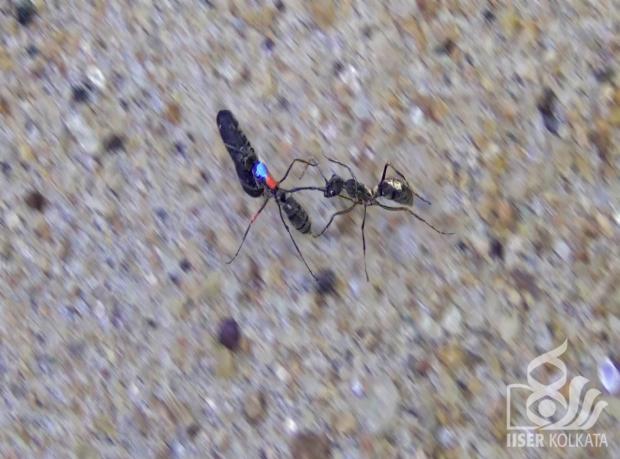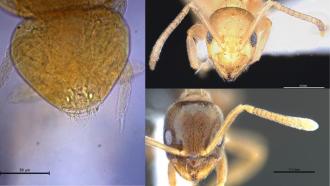
Photo: IISER- Kolkata
Distressingly dark facets of societies such as kidnapping, rape, thievery, slavery, and murder of members of one’s own species, are not unique to human communities. Monkeys, dolphins, mice, eagles, ants and many other members of the animal kingdom are known to exhibit various instances of such behaviour. Observation of such sinister acts is fascinating to researchers, who investigate further, speculating on the significance of such an act in the light of animal cognition and how they have evolved. The serendipitous discovery of ‘brood theft’ in a group of ants in the Ant Lab at IISER Kolkata, for instance, has Prof. Sumana Annagiri and her team conducting many experiments to figure out how do they do it and why.
When Prof. Annagiri first relocated from the US to her new lodgings at IISER Kolkata, she observed a group of ants moving into to her new residence, with her. The ants were carrying their brood, which consists of eggs, larvae and pupae. The scene enchanted the professor and she found out that this species, known as Diacamma indicum, belonged to a primitive family of ants known as Ponerinae.The fascination soon became the object of study in the Ant Lab that she set up at IISER. It’s been 8 years now, and hers is the only lab in the country dedicated to studying these amazing little creatures.
The Ant lab has more than one ‘accidental’ coincidence that has resulted in understanding various facets of ants’ social living. Ms. Manabi, a senior research fellow at IISER, Kolkata, worked with Prof. Annagiri, on a month-long project. It was during this period that Ms. Manabi first noticed the thievish nature of these ants. Ants from one colony were observed stealing pupae from another’s colony and bringing it back to their own residence. What ensued was a series of experiments implemented to further investigate this occurrence.
Brood theft has been observed previously in the ant world; some ants in the temperate regions are known to steal brood from their neighbours. The stealing, in those species, is almost like a well-organised crime and is termed ‘slave raids’. It starts with one ant first identifying a neighbouring colony followed by a group of ants marching out with the purpose of stealing – they go inside, raid the colony and they bring the neighbour’s pupa to their own.
“When we saw that Diacamma indicumwere stealing, we were quite taken aback, because in the tropics, no species of ants is known to steal”, says Prof. Annagiri. “For the first time, we observed brood theft in the tropics, in a primitive ant species, allowing us to speculate that slavery evolved a few thousand years earlier than what is currently understood!”, she quips. Following this discovery, Mr. Bishwarup, one of Prof. Annagiri’s PhD students, took it upon himself to investigate ‘the case of the stolen pupae’.
Mr. Bishwarup’s study reveals the extent of stealing and the manner in which stealing occurs. Firstly, the ants preferred stealing pupae to eggs or larvae, possibly because puape has already recived all the investment required to make an adult ant. Secondly, the stolen brood are not eaten; instead, they are allowed to grow and then are incorporated as slaves into their community. Thirdly, the colonies are much more vulnerable to theft during relocation since the pupae are unsheltered and their nest no longer offers protection. Lastly, the kidnappers don’t necessarily differentiate between their own pupae and the neighbour’s – if they find a pupa anywhere, they tend to pick it up and bring it, sort of like a rescue operation.
“We actually witnessed the theft and then confirmed it with a number of other behavioural tests, which is quite amazing”, says the Professor. The team even captured videographic evidence of the theft! “The next step”, she adds, “is to quantify its occurrences in nature by conducting DNA analysis on the relatedness of colony members to see how many ‘slaves’ are present.”
So, what triggers an ant to go to a neighbour’s colony, steal a pupa and run back home with it? Is it, in fact, ‘stealing’ at all? Do these ants employ cognition in this process? Do they realise that they are stealing and exhibit a different behaviour than rescue? What, then, are the steps to stealing? The observation of brood theft has raised a frenzy in the Ant Lab, with Prof. Annagiri looking forward to study the act of theft in the perspective of behavioural steps involved and their cognition.






